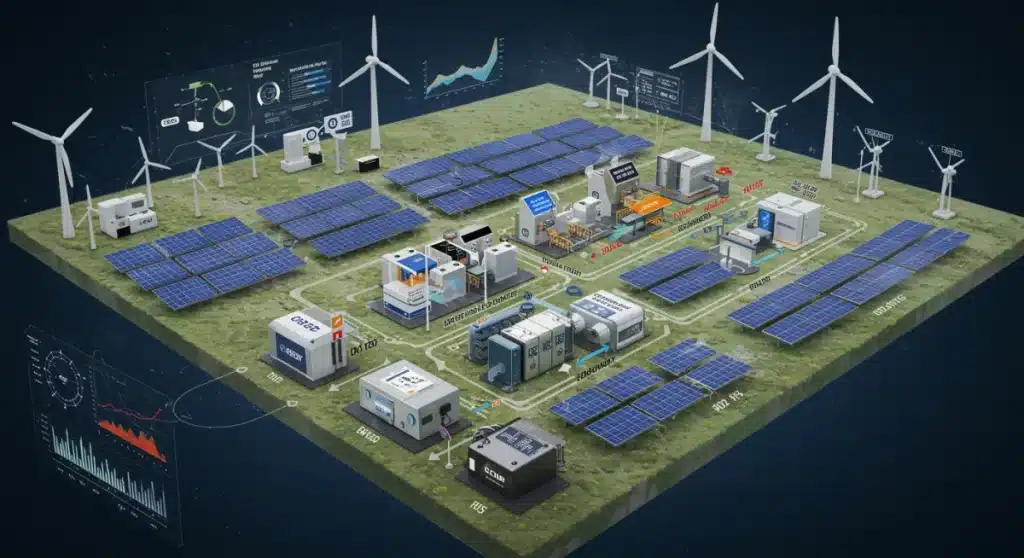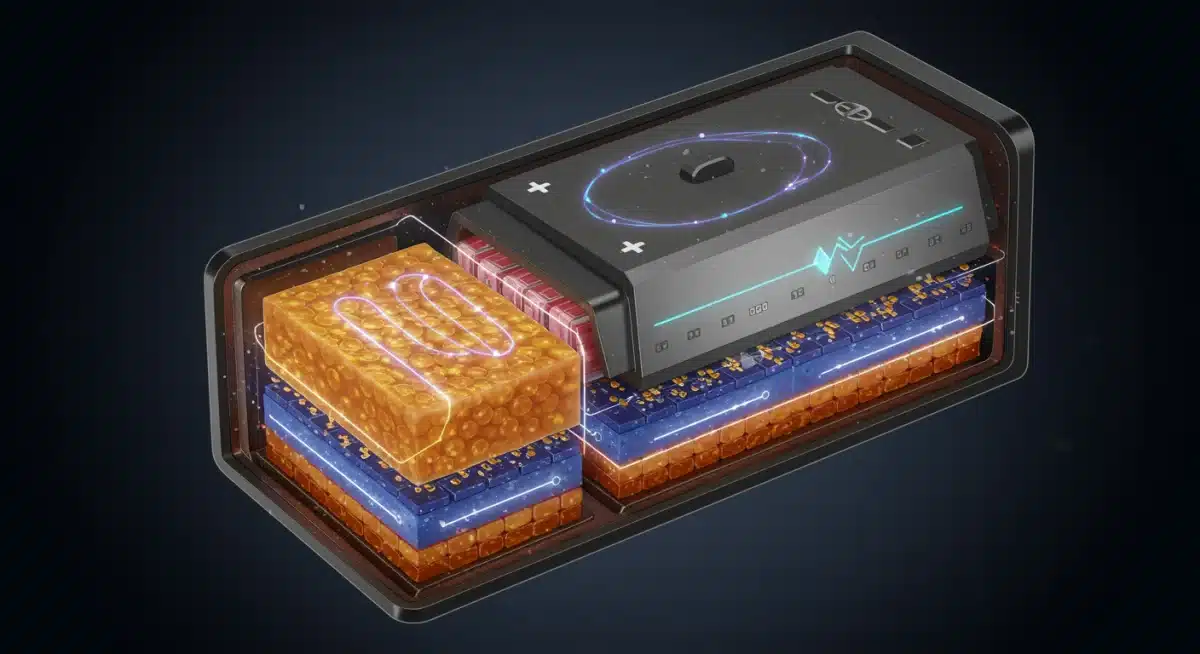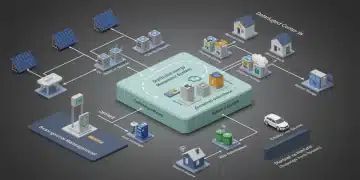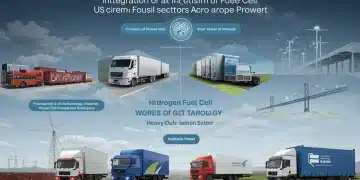Battery Storage Breakthroughs: US Renewable Grids in 2025

Recent advancements in battery storage are poised to transform US renewable grids by 2025, with key developments in solid-state batteries, flow battery systems, and AI-driven grid integration promising enhanced reliability and sustainability.
As of late 2024, the landscape of energy storage is rapidly evolving, with significant advancements promising to reshape US battery storage capabilities for renewable grids by 2025. These breakthroughs are critical for enhancing grid stability, integrating more intermittent renewable energy sources like solar and wind, and ultimately accelerating the transition to a cleaner energy future. Industry experts and recent reports indicate substantial progress in three core areas that will redefine how the US powers its homes and industries.
Next-Generation Solid-State Batteries Elevate Safety and Efficiency
Solid-state battery technology is emerging as a game-changer for energy storage, moving beyond traditional lithium-ion limitations. These batteries, which utilize solid electrolytes instead of liquid ones, offer significant improvements in safety, energy density, and cycle life, making them ideal for grid-scale applications.
The elimination of flammable liquid electrolytes addresses one of the primary safety concerns associated with current battery technologies. This inherent safety feature is particularly attractive for large-scale deployments within urban settings or sensitive environmental areas, where fire risks must be minimized.
Improved Energy Density and Lifespan
Recent laboratory trials and pilot projects across the US are demonstrating unprecedented energy densities for solid-state cells. This means smaller footprints for storage facilities, a crucial advantage in land-constrained areas. Furthermore, the robust nature of solid electrolytes contributes to a longer operational lifespan, reducing replacement costs and enhancing overall economic viability.
- Enhanced Safety: Non-flammable solid electrolytes reduce fire hazards significantly.
- Higher Energy Density: More energy stored in a smaller volume, optimizing space.
- Extended Cycle Life: Greater durability and longer operational periods, lowering maintenance.
- Faster Charging Rates: Potential for quicker energy absorption and discharge, improving grid responsiveness.
Companies like QuantumScape and Solid Power are at the forefront of these developments, reporting successful tests with prototype cells that exceed current lithium-ion performance metrics. These advancements suggest that by 2025, we could see initial commercial deployments specifically tailored for grid support, offering a safer and more efficient alternative.
Advanced Flow Battery Systems for Long-Duration Storage
While solid-state batteries excel in energy density and safety, flow battery systems are carving out a critical niche in long-duration energy storage. These systems store energy in liquid electrolyte tanks, separate from the power conversion components, allowing for flexible scaling of power and energy independently. This characteristic makes them exceptionally well-suited for applications requiring several hours to days of discharge, a crucial need for a grid increasingly reliant on intermittent renewables.
Recent innovations in electrolyte chemistry and system design are significantly boosting the performance and cost-effectiveness of flow batteries. Vanadium redox flow batteries (VRFBs) continue to lead this segment, but new chemistries, including zinc-bromine and organic flow batteries, are gaining traction.
Cost Reductions and Scalability
The modular design of flow batteries allows for easy scalability, making them adaptable to various grid demands, from small community microgrids to large utility-scale installations. As manufacturing processes become more refined and raw material costs stabilize, the levelized cost of storage (LCOS) for flow batteries is projected to decrease substantially by 2025, according to a report by the US Department of Energy.
- Independent Scaling: Power and energy can be scaled separately, offering design flexibility.
- Long-Duration Discharge: Ideal for storing energy over extended periods, up to multiple days.
- Reduced Degradation: Electrolytes generally do not degrade over time, preserving capacity.
- Environmental Friendliness: Many flow battery chemistries use non-toxic or recyclable materials.
Companies such as ESS Inc. and Invinity Energy Systems are actively deploying and refining their iron flow and vanadium flow battery solutions, respectively. Their projects are demonstrating the viability of these systems for utilities seeking reliable, long-term storage solutions to balance supply and demand fluctuations from renewable sources.

AI-Driven Grid Integration and Predictive Analytics
Beyond the physical battery technologies themselves, the intelligence behind their operation is undergoing a revolution. Artificial intelligence (AI) and machine learning (ML) are becoming indispensable tools for optimizing battery storage systems within the broader renewable grid. These advanced algorithms enable predictive analytics, real-time demand response, and intelligent energy routing, maximizing the efficiency and economic benefits of stored energy.
AI can forecast renewable energy generation with greater accuracy, anticipate demand peaks, and even predict potential grid instabilities. This foresight allows battery storage systems to charge and discharge optimally, preventing curtailment of renewable energy and ensuring a stable power supply.
Optimizing Performance and Revenue Streams
The integration of AI into grid operations is not just about technical efficiency; it also unlocks new revenue opportunities for battery storage operators. By participating in wholesale energy markets and providing ancillary services, AI-optimized systems can generate significant value, further incentivizing investment in storage infrastructure. Real-time data analysis allows for dynamic participation, adapting to market price fluctuations and grid needs instantaneously.
Leading energy technology firms like Stem and Fluence are deploying sophisticated AI platforms that manage vast networks of distributed energy resources, including battery storage. These platforms use complex algorithms to learn from historical data and real-time conditions, continuously refining their operational strategies. This intelligence is crucial for the seamless and cost-effective integration of high penetrations of renewable energy into the US grid by 2025.
Enhanced Grid Resilience Through Hybrid Systems
The future of US battery storage for renewable grids increasingly points towards hybrid systems that combine different storage technologies and integrate them with renewable generation. These hybrid solutions leverage the strengths of each component, creating a more robust and flexible energy infrastructure. For instance, a hybrid system might pair a fast-responding lithium-ion battery with a long-duration flow battery and a solar PV array.
This multi-faceted approach offers superior adaptability to varying grid conditions and demands. During periods of high demand or low renewable output, the fast-acting batteries can provide immediate power, while the long-duration systems ensure sustained supply. This not only enhances reliability but also optimizes the economic dispatch of energy resources.
Synergistic Benefits and Operational Flexibility
Hybrid systems are designed to maximize the synergistic benefits of diverse technologies. The rapid response of lithium-ion, coupled with the extended capacity of flow batteries, creates a comprehensive solution that can address both short-term fluctuations and prolonged energy deficits. This operational flexibility is paramount for grids aiming for high renewable energy penetration, where variability is a constant challenge.
- Diverse Capabilities: Combines strengths of multiple storage types (e.g., fast response and long duration).
- Increased Reliability: Provides consistent power even with intermittent renewable sources.
- Optimized Resource Use: Each component operates where it is most efficient.
- Cost-Effective Solutions: Potentially lowers overall system cost by matching technology to specific needs.
Several utility-scale projects are already exploring and implementing hybrid solutions. For example, some sites are integrating solar farms with both lithium-ion and flow batteries to optimize energy capture and delivery, demonstrating a pathway for widespread adoption by 2025. These projects are crucial testbeds for refining the control systems and economic models that will underpin future grid architectures.
Policy and Investment Driving Innovation
The rapid advancements in US battery storage technologies are significantly bolstered by supportive government policies and substantial private investment. Federal initiatives, such as the Inflation Reduction Act (IRA), provide significant tax credits and incentives for clean energy technologies, including energy storage. These policies are creating a favorable environment for research, development, and deployment of innovative battery solutions.
Private capital is also flowing into the sector at an unprecedented rate, with venture capitalists and institutional investors recognizing the immense potential of grid-scale storage. This influx of funding accelerates the commercialization of new technologies and enables manufacturers to scale up production, driving down costs and increasing availability.
Strategic Public-Private Partnerships
The collaboration between government agencies, national laboratories, and private industry is proving instrumental. Public-private partnerships are fostering critical research and development, bridging the gap between scientific discovery and market-ready solutions. These partnerships often focus on overcoming technical hurdles, improving manufacturing processes, and developing robust supply chains for key battery components.
For example, the Department of Energy’s initiatives, coupled with private sector investments, are targeting specific areas like domestic battery manufacturing and rare earth mineral processing. This strategic focus aims to reduce reliance on foreign supply chains and enhance energy security. The combination of policy support and robust investment is a powerful catalyst, ensuring that the US remains at the forefront of battery storage advancements.
Challenges and the Path Forward
Despite the promising breakthroughs, the path to widespread adoption of advanced US battery storage technologies by 2025 is not without its challenges. Supply chain vulnerabilities, particularly for critical minerals like lithium, cobalt, and nickel, remain a concern. Geopolitical factors and fluctuating commodity prices can impact the cost and availability of these essential materials, potentially slowing down deployment.
Another significant hurdle is the need for continued investment in grid infrastructure upgrades. While new battery technologies offer immense benefits, their full potential can only be realized with a modern, resilient grid capable of handling bidirectional power flow and advanced control systems. Regulatory frameworks also need to evolve to properly value the services provided by energy storage, ensuring fair compensation and clear market signals for investors.
Addressing Supply Chain and Infrastructure Needs
Efforts are underway to mitigate supply chain risks through diversification, recycling initiatives, and the development of alternative battery chemistries that rely on more abundant materials. Companies are investing in domestic mining and processing capabilities to create a more secure and sustainable supply chain within the US.
- Supply Chain Diversification: Exploring new sources and reducing reliance on single regions.
- Recycling Programs: Developing robust infrastructure for battery recycling to recover valuable materials.
- Grid Modernization: Investing in smart grid technologies to integrate storage effectively.
- Evolving Regulations: Adapting policies to support energy storage as a critical grid asset.
Addressing these challenges requires a concerted effort from policymakers, industry leaders, and researchers. The pace of innovation suggests that many of these issues are being actively tackled, with solutions expected to mature significantly by 2025, paving the way for a more resilient and sustainable energy future for the US.
| Key Development | Brief Description |
|---|---|
| Solid-State Batteries | Enhanced safety, higher energy density, and longer lifespans for grid applications. |
| Flow Battery Systems | Cost-effective, scalable solutions for long-duration energy storage, ideal for balancing renewables. |
| AI Grid Integration | AI and ML optimize battery operation, predict demand, and enhance grid stability and revenue. |
| Hybrid Storage Systems | Combining different battery types for superior resilience and operational flexibility. |
Frequently Asked Questions About US Battery Storage
The increasing integration of intermittent renewable energy sources like solar and wind into the US grid is the primary driver. Advanced battery storage ensures grid stability, reliability, and efficient energy management, preventing curtailment and optimizing renewable output.
Solid-state batteries use a solid electrolyte instead of a liquid one, enhancing safety by eliminating flammable components. They also offer higher energy density and longer cycle lives, making them more durable and efficient for grid-scale applications.
AI and machine learning algorithms optimize battery charging and discharging cycles by predicting energy generation and demand. This maximizes efficiency, reduces costs, and allows storage systems to participate in energy markets, enhancing grid responsiveness and profitability.
Yes, flow batteries are highly viable for long-duration storage due to their ability to scale power and energy independently. They can store energy for extended periods, from several hours to days, making them excellent for balancing intermittent renewable energy supplies.
The Inflation Reduction Act (IRA) offers significant tax credits and incentives for clean energy technologies, including battery storage. These policies encourage investment, research, and deployment, accelerating the transition to a more sustainable and resilient energy grid.
What Happens Next
The unfolding developments in US battery storage are not merely technological curiosities but foundational shifts that will redefine the nation’s energy infrastructure. As 2025 approaches, observers should monitor the commercialization timelines of solid-state and advanced flow battery systems, alongside the increasing sophistication of AI-driven grid management. We anticipate a continued surge in utility-scale deployments and a growing emphasis on domestic manufacturing to secure supply chains. The convergence of these innovations promises a more resilient, efficient, and sustainable energy future for the United States, with profound implications for both environmental goals and economic stability.





